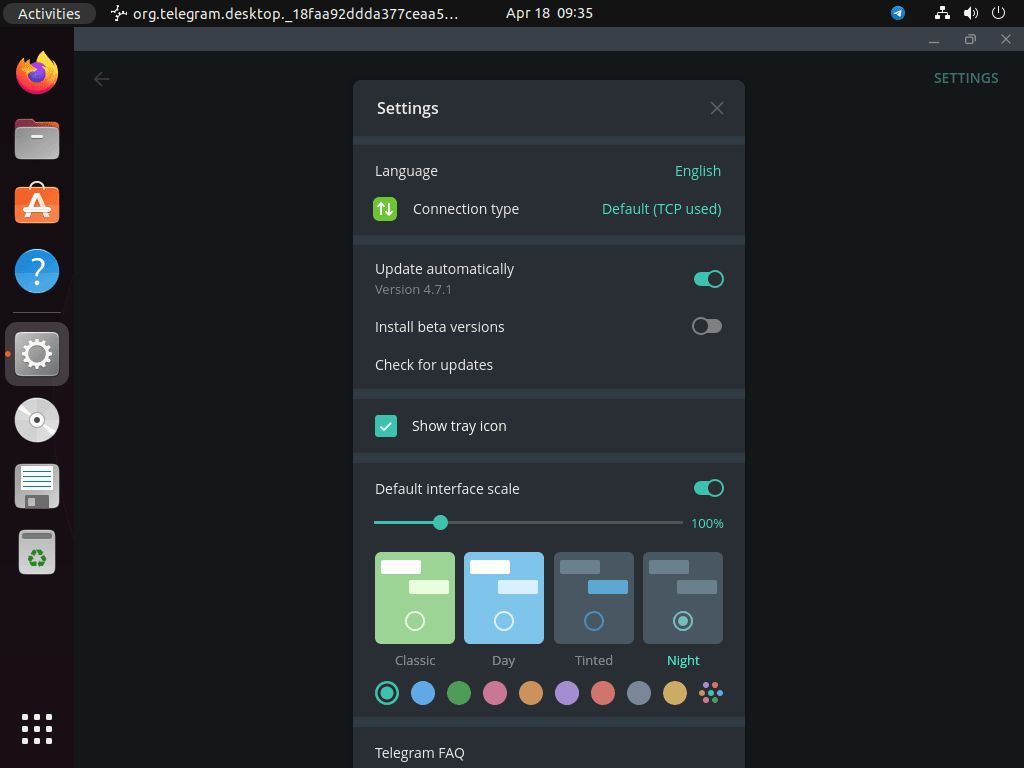Telegram is a lightweight messaging app that prioritizes speed and privacy over bloat. Unlike heavier alternatives, Telegram starts instantly, handles groups of 200,000+ members, and delivers files up to 2 GB each. Furthermore, for Linux users, this means a responsive desktop client that syncs seamlessly across devices without the overhead of traditional messaging platforms.
To install Telegram on Ubuntu, you have four methods to choose from: APT repositories for system integration, a PPA for the latest upstream builds, Flatpak for sandboxed isolation, or Snap for zero-maintenance automatic updates. Additionally, this guide covers installation, launch, updates, and removal for each method so you can pick the approach that matches your workflow and preferences.
How to Install Telegram on Ubuntu: Choose Your Method
Before proceeding with installation, review the comparison table below. Each method offers different trade-offs between stability, features, and maintenance requirements, so you can choose the best approach for your needs.
| Method | Version/Channel | Updates | Best For |
|---|---|---|---|
| APT Default Repository | Stable (may lag upstream) | System updates | Production stability, minimal maintenance |
| APT with atareao PPA | Latest upstream releases | System updates | Current features, system integration |
| Flatpak | Latest stable | Automatic via Flatpak | Sandboxed security, cross-distro compatibility |
| Snap | Latest stable | Automatic background updates | Zero-maintenance, automatic updates |
Method 1: Install Telegram via APT
Update System Packages
First, update your system to ensure you have the latest software and security patches. This helps prevent potential conflicts during installation:
sudo apt update && sudo apt upgradeInstall Telegram Using APT
Telegram can be installed using the APT package manager in two ways: from the default APT repository or using a PPA for the latest versions. Here’s how to choose between them:
Option 1: Install Telegram from Default Repository
The default APT repository offers a stable version of Telegram that is thoroughly tested for Ubuntu compatibility. Consequently, this method works well for most users who prioritize stability over having the absolute latest features. To install from the default repository:
sudo apt install telegram-desktopOption 2: Install Telegram Using atareao PPA
For the latest Telegram releases, install from the atareao PPA. Personal Package Archives (PPAs) are third-party repositories maintained by community developers that provide more current software versions than default Ubuntu repositories. Moreover, the atareao PPA is community-maintained and widely trusted for Telegram updates, tracking upstream releases closely while maintaining APT integration. To add the PPA to your system:
sudo add-apt-repository ppa:atareao/telegram -yAfter adding the PPA, update your package list to recognize the new repository:
sudo apt updateNext, install the latest Telegram version from the PPA:
sudo apt install telegramThe default repository installs the
telegram-desktoppackage, while the PPA installs thetelegrampackage. Both provide the same application but use different package names. Choose the PPA if you need the latest features and security updates, or stick with the default repository for maximum stability.
Method 2: Install Telegram via Flatpak
Flatpak is a universal package management system that runs applications in sandboxed environments, isolating them from your system libraries and other applications for enhanced security. Furthermore, this method provides automatic updates and works consistently across different Linux distributions. However, if Flatpak isn’t installed on your system, refer to the Flatpak installation guide for setup instructions.
Add Flathub Repository
First, add the Flathub repository, which hosts the Telegram Flatpak package. Specifically, Flathub is the primary repository for Flatpak applications and provides verified, up-to-date packages:
sudo flatpak remote-add --if-not-exists flathub https://flathub.org/repo/flathub.flatpakrepoInstall Telegram Using Flatpak
Next, after adding Flathub, install Telegram with the following command:
sudo flatpak install flathub org.telegram.desktop -yOnce installation completes, Telegram runs in a sandboxed Flatpak environment, isolated from other applications and system libraries for enhanced security and stability.
Method 3: Install Telegram via Snap
Snap is a universal packaging format that provides automatic background updates and self-contained installations. Therefore, this method is ideal for users who want zero-maintenance updates without manual intervention.
Verify Snap Installation
Snap comes pre-installed on most Ubuntu systems. However, if Snap is not available on your installation, then install it with this command:
sudo apt install snapd -yThis step installs the snapd daemon, which manages Snap packages on your system.
Install Telegram Using Snap
Once snapd is ready, Snap automatically downloads the base runtime required by each application, and Telegram uses the core24 base, so you can install it directly:
sudo snap install telegram-desktopLaunch Telegram Application
After installing Telegram, you can launch the application using either command-line or graphical interface methods. Both approaches open the same application, so choose whichever fits your workflow.
Launch Telegram from Terminal
You can launch Telegram immediately after installation by typing the following command in your terminal:
telegram-desktopAlternatively, for PPA installations, the package stores Telegram under /opt/telegram/Telegram, so you’ll need to launch it with the full path:
/opt/telegram/TelegramHowever, if you want a shorter command, create a symlink so the binary appears in your PATH:
sudo ln -s /opt/telegram/Telegram /usr/local/bin/telegramOnce created, you can then launch it with telegram like any other terminal command.
Alternatively, Flatpak users can run Telegram from the terminal using the following command:
flatpak run org.telegram.desktopFor Snap installations, launch Telegram from the terminal using this command:
snap run telegram-desktopLaunch Telegram from Applications Menu
Alternatively, you can launch Telegram through the graphical Applications menu:
- Click on the “Activities” button at your screen’s top-left corner.
- Click on “Show Applications” (usually represented by a grid of dots).
- Search for “Telegram” in the search bar or locate it in the list of installed applications.
- Click on the “Telegram” icon to launch the application.


Update and Remove Telegram
Update Telegram
Regular updates ensure you receive the latest features and security patches. However, update commands vary by installation method:
APT Telegram Update Method
Refresh repository indexes and upgrade packages with APT:
sudo apt update && sudo apt upgradeFlatpak Telegram Update Method
Refresh your Flatpak runtimes and applications:
sudo flatpak updateSnap Telegram Update Method
Refresh your Snap packages with elevated privileges:
sudo snap refreshRemove Telegram
To uninstall Telegram, use the removal command matching your installation method:
APT Telegram Remove Method
For default repository installations, remove the telegram-desktop package:
sudo apt remove telegram-desktopAlternatively, for PPA installations, remove the telegram package and optionally remove the PPA repository:
sudo apt remove telegramFollowing that, remove the atareao PPA from your system using this command (or refer to the remove a PPA on Ubuntu guide for more details):
sudo add-apt-repository --remove ppa:atareao/telegram -yFlatpak Telegram Remove Method
Delete the Flatpak build along with its stored data:
sudo flatpak remove --delete-data org.telegram.desktop -ySnap Telegram Remove Method
Remove the Snap package completely:
sudo snap remove telegram-desktopConclusion
Telegram is now installed and ready to use across all your Ubuntu systems and devices. Whether you choose APT for stable system integration, the PPA for the latest features, Flatpak for isolated security, or Snap for hands-off updates, each method keeps your installation fresh without ongoing maintenance. Ultimately, you now have the flexibility to switch methods or manage Telegram alongside your other Ubuntu applications with confidence.




I see the screen saying “start messaging”, but, when I click on this, I see another screen with a QR code which changes every few minutes. It says :
Scan From Mobile Telegram
1. Open Telegram on your phone
2. Go to Settings > Devices > Link Desktop
3. Scan this image to Log In
Or log in using your phone number
NOW THE WHOLE POINT of trying to get telegram on the Ubuntu pc IS THAT I NEITHER HAVE NOR WANT A *** SMARTPHONE!
Thanks for reporting this, Alain. You’re seeing Telegram’s QR code login screen, which appears by default but isn’t required. To bypass the QR code and register without a smartphone, look for the “Or log in using your phone number” option at the bottom of that screen and click it. This opens the classic login form where you can enter your phone number directly.
Telegram will then send a verification code via SMS or an automated voice call, depending on whether you use a mobile phone or a landline. After entering the code, you can use Telegram Desktop on Ubuntu without needing a mobile app.
What do you need to create an account on telegram ?
Thanks for your question, John. To create a Telegram account, you only need a valid phone number (mobile or landline). During registration, Telegram sends a verification code via SMS to confirm your number. Once you enter the code, you can set your display name and optionally add a username, profile photo, and bio. No email address is required, though you can add one later for account recovery purposes.
After installing Telegram using any of the methods covered in this guide, launch the application and follow the on-screen registration prompts to get started.